METTL7B-induced histone lactylation prevents heart failure by ameliorating cardiac remodelling
IF 4.7
2区 医学
Q1 CARDIAC & CARDIOVASCULAR SYSTEMS
引用次数: 0
Abstract
Introduction
Lactylation is important for a variety of biological activities. It is reported that Class I histone deacetylases (HDAC1–3) are histone lysine delactylases. However, the role of lactylation in cardiac remodelling remains uncertain.
Objectives
To explore a novel regulator of lactylation and elucidate their functional mechanisms in cardiac remodelling and heart failure.
Methods
GSE36961, GSE141910 and GSE174691 related to HCM (hypertrophic cardiomyopathy) were separately acquired from Gene expression Omnibus. Candidate genes related to both HCM and histone lactylation were determined by the intersection of DEGs (differentially expressed genes) and module genes sifted by WGCNA (Weighted Gene Co-Expression Network Analysis). METTL7B was screened out and its expression in hypertrophic myocardium was measured by qRT-PCR and western blotting. Furthermore, immunofluorescence, immunoprecipitation, and RNA pull-down assays were utilized to identify the biological functions of METTL7B. The myocardial biopsy of HCM and transverse aortic constriction (TAC) mouse model were performed to analyze the effects of METTL7B on cardiac remodelling in vivo.
Results
We observed that the expression of METTL7B was down-regulated in hypertrophic myocardium, and the lactylation level was increased during the early stage and falling rapidly in the process of cardiac remodelling. Furthermore, we demonstrated that sodium lactate (NALA) administration fulfil a protective role on cardiac remodelling, and METTL7B alleviates cardiac remodelling and improves heart function by maintaining the activation of histone lactylation possibly at the later stage. Impressively, METTL7B suppressed the expression of USP38 via m6A dependent mRNA degradation, resulting in increasing ubiquitylation of HDAC3, which is a proven histone lysine delactylases.
Conclusion
We identifed METTL7B as a potential therapeutic target for myocardial remodelling and showed that it played a critical role in the promotion of myocardial lactylation, which is beneficial for improvement of cardiac function and attenuation of cardiac remodelling.
mettl7b诱导的组蛋白乳酸化通过改善心脏重构来预防心力衰竭。
简介:乳酸化对多种生物活性具有重要意义。一类组蛋白去乙酰化酶(HDAC1-3)是组蛋白赖氨酸去乙酰化酶。然而,乳酸化在心脏重构中的作用仍然不确定。目的:探索一种新的乳酸化调节因子,并阐明其在心脏重构和心力衰竭中的作用机制。方法:分别从基因表达图谱中获得与肥厚性心肌病相关的GSE36961、GSE141910和GSE174691。通过deg(差异表达基因)和WGCNA(加权基因共表达网络分析)筛选的模块基因的交集来确定与HCM和组蛋白乳酸化相关的候选基因。筛选METTL7B,采用qRT-PCR和western blotting检测其在肥厚心肌中的表达。此外,利用免疫荧光法、免疫沉淀法和RNA拉下法鉴定METTL7B的生物学功能。通过HCM和横断主动脉缩窄(TAC)小鼠模型的心肌活检,分析METTL7B对心脏重构的影响。结果:我们观察到METTL7B在肥厚心肌中表达下调,乳酸化水平在早期升高,在心脏重构过程中迅速下降。此外,我们证明了乳酸钠(NALA)对心脏重构具有保护作用,而METTL7B可能在后期通过维持组蛋白乳酸化激活来减轻心脏重构并改善心脏功能。令人印象深刻的是,METTL7B通过m6A依赖性mRNA降解抑制USP38的表达,导致HDAC3泛素化增加,HDAC3是一种被证实的组蛋白赖氨酸脱乙酰酶。结论:METTL7B是心肌重构的潜在治疗靶点,在促进心肌乳酸化方面发挥关键作用,有利于改善心功能,减轻心肌重构。
本文章由计算机程序翻译,如有差异,请以英文原文为准。
求助全文
约1分钟内获得全文
求助全文
来源期刊
CiteScore
10.70
自引率
0.00%
发文量
171
审稿时长
42 days
期刊介绍:
The Journal of Molecular and Cellular Cardiology publishes work advancing knowledge of the mechanisms responsible for both normal and diseased cardiovascular function. To this end papers are published in all relevant areas. These include (but are not limited to): structural biology; genetics; proteomics; morphology; stem cells; molecular biology; metabolism; biophysics; bioengineering; computational modeling and systems analysis; electrophysiology; pharmacology and physiology. Papers are encouraged with both basic and translational approaches. The journal is directed not only to basic scientists but also to clinical cardiologists who wish to follow the rapidly advancing frontiers of basic knowledge of the heart and circulation.

 求助内容:
求助内容: 应助结果提醒方式:
应助结果提醒方式:


